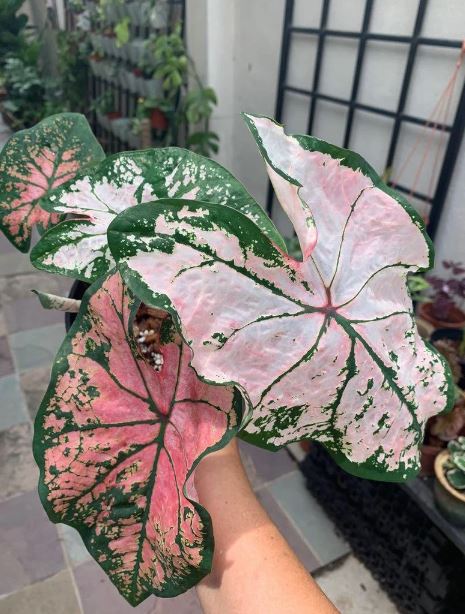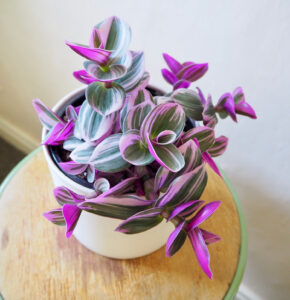Pink Princess
The Pink Princess Beauty Plant, also known as Caladium bicolor ‘Pink Princess,‘ is a stunning tropical plant with large, heart-shaped leaves that are primarily pink and green, with splashes of white. Here are some details about the plant:
- Native to South America, the Pink Princess Beauty Plant is typically grown as a houseplant in other parts of the world, but can also be grown outdoors in warm, humid climates.
- The plant typically grows to be 1-2 feet tall and wide, but can grow larger under optimal conditions.
- It thrives in bright, indirect light and warm temperatures between 65-80°F. It does not do well in direct sunlight or temperatures below 60°F.
- The Pink Princess Beauty Plant requires well-draining soil and should be watered regularly to keep the soil moist, but not waterlogged.
- It is important to note that the Pink Princess Beauty Plant is toxic to pets and humans if ingested, so it should be kept out of reach of children and pets.
- The plant can be propagated through division, which involves separating the plant into smaller sections and repotting them separately.
- The Pink Princess Beauty Plant is a relatively low-maintenance plant that can add a pop of color to any indoor space. However, it is important to note that the pink coloring can fade in lower light conditions, so it may require some extra care to maintain its vibrant colors.
Dimensions
Relatively small plant that can grow up to 1-2 feet in height and spread. However, the exact dimensions of the plant can vary depending on factors such as growing conditions and care.
The leaves of the Pink Princess Beauty Plant can grow to be quite large, up to 10-18 inches long and 8-14 inches wide. The heart-shaped leaves have a pointed tip and can be pink, green, and white, with a variety of patterns and variations in color.
Overall, the Pink Princess Beauty Plant is a compact and bushy plant that can fit well on a tabletop or in a smaller pot, making it a popular choice for indoor decoration.
Zones
Tropical plant that is typically grown as a houseplant or in outdoor gardens in warm, humid climates. It is not cold-hardy and cannot survive freezing temperatures.
The plant is native to South America and thrives in warm, tropical climates. It prefers temperatures between 65-80°F and high humidity levels. In the United States, the Pink Princess Beauty Plant can be grown outdoors in USDA plant hardiness zones 9-11, which include southern Florida, parts of southern Texas, and some coastal areas of California.
In colder regions, the Pink Princess Beauty Plant should be grown indoors in a warm, bright location, or in a greenhouse or conservatory. It is important to protect the plant from drafts and temperatures below 60°F, as this can cause damage or death to the plant.
How to Tend
Inside
The Pink Princess Beauty Plant (Caladium bicolor ‘Pink Princess’) is a beautiful houseplant that can add a pop of color to any indoor space. Here are some tips on how to care for your Pink Princess Beauty Plant:
- Light: Prefers bright, indirect light. Direct sunlight can scorch the leaves, so it is best to place the plant near a window that receives bright, indirect light. If you notice the plant’s leaves are fading or losing color, it may need more light.
- Water: Likes to be kept consistently moist, but not waterlogged. Water the plant when the top inch of soil feels dry to the touch. Avoid letting the soil dry out completely, as this can cause the leaves to wilt. Overwatering can also be a problem, as it can lead to root rot.
- Humidity: Thrives in high humidity levels. If the air in your home is dry, you can increase the humidity around the plant by placing a humidifier nearby or by setting the pot on a tray filled with pebbles and water.
- Temperature: Prefers warm temperatures between 65-80°F. It is important to keep the plant away from drafts and air conditioning vents, as this can cause damage to the leaves.
- Soil: Requires well-draining soil that is rich in organic matter. A high-quality potting mix with added perlite or vermiculite can work well. Make sure the pot has drainage holes to prevent waterlogging.
- Fertilizer: You can fertilize the Pink Princess Beauty Plant every 2-4 weeks during the growing season (spring and summer) with a balanced, water-soluble fertilizer. Be sure to follow the package instructions and do not over-fertilize, as this can burn the plant’s roots.
- Pruning: If the plant becomes leggy or overgrown, you can prune back the stems to encourage bushier growth. Remove any yellowing or damaged leaves as needed.
- Propagation: Can be propagated through division, which involves separating the plant into smaller sections and repotting them separately. Wait until the plant has developed several healthy stems before attempting to propagate.
Outside
The Pink Princess Beauty Plant (Caladium bicolor ‘Pink Princess’) is a tropical plant that can be grown outdoors in warm, humid climates. Here are some tips on how to care for your Pink Princess Beauty Plant if you are growing it outside:
- Light: Prefers bright, indirect light or partial shade. Direct sunlight can scorch the leaves, so it is best to place the plant in a location that receives bright, indirect light or partial shade.
- Water: Likes to be kept consistently moist, but not waterlogged. Water the plant when the top inch of soil feels dry to the touch. Avoid letting the soil dry out completely, as this can cause the leaves to wilt. Overwatering can also be a problem, as it can lead to root rot.
- Soil: Requires well-draining soil that is rich in organic matter. A high-quality potting mix with added perlite or vermiculite can work well. If you are planting the Pink Princess Beauty Plant outside, make sure the soil is well-draining and has plenty of organic matter.
- Fertilizer: You can fertilize the Pink Princess Beauty Plant every 2-4 weeks during the growing season (spring and summer) with a balanced, water-soluble fertilizer. Be sure to follow the package instructions and do not over-fertilize, as this can burn the plant’s roots.
- Temperature: Prefers warm temperatures between 65-80°F. It is important to protect the plant from cold temperatures, as this can cause damage or death to the plant.
- Humidity: Thrives in high humidity levels. If you live in a dry climate, you can increase the humidity around the plant by misting it with water or setting up a humidifier nearby.
- Pruning: If the plant becomes leggy or overgrown, you can prune back the stems to encourage bushier growth. Remove any yellowing or damaged leaves as needed.
- Propagation: The Pink Princess Beauty Plant can be propagated through division, which involves separating the plant into smaller sections and repotting them separately. Wait until the plant has developed several healthy stems before attempting to propagate.
Where to Purchase
You can buy this bulb at our Esty shop. Happy Shopping!!


